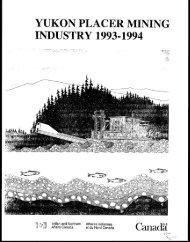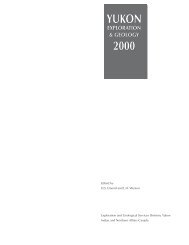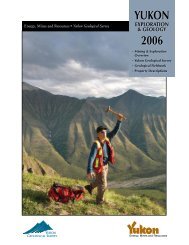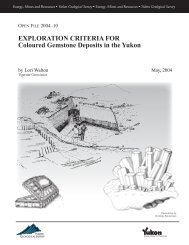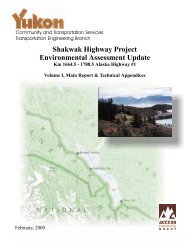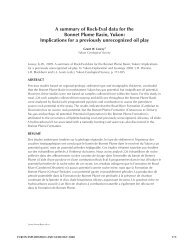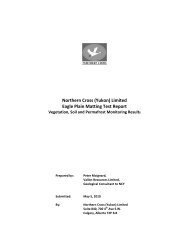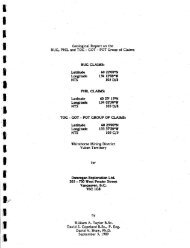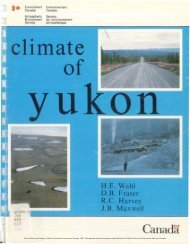WhiteCAP_Plan_01SEPT..
WhiteCAP_Plan_01SEPT..
WhiteCAP_Plan_01SEPT..
Create successful ePaper yourself
Turn your PDF publications into a flip-book with our unique Google optimized e-Paper software.
Northern Climate ExChange <strong>WhiteCAP</strong> Draft <strong>Plan</strong><br />
The population of Whitehorse has become increasingly stable over the past few<br />
decades. 78% of individuals registered as permanent residents who had lived in the<br />
community for over five years (Kischuk, 2009). The decreased mobility of the community<br />
increases its adaptive capacity because permanent residents tend to have a greater<br />
investment in their community and are therefore more likely to take action under adverse<br />
conditions. In addition, 19% of the Whitehorse population has identified as “aboriginal 7 ”<br />
(YBS, 2008b). The proportion of indigenous peoples in the community supports a strong<br />
sense of place and connection to the region.<br />
3.2 Biophysical Profile of the Whitehorse Region<br />
Climate change vulnerability for the community arises from biophysical characteristics<br />
such as topography, hydrology, freeze-thaw activity, and local biodiversity. The City of<br />
Whitehorse is located along the Yukon River in relatively mountainous terrain. It is a<br />
community squarely within the boreal forest. As illustrated in Figure 3.1, the city is a<br />
distributed urban system, characterized by extensive linear infrastructure and relatively<br />
secluded subdivisions. Country residential neighbourhoods on the periphery of the<br />
community, such as Mary Lake, Wolf Creek and Hidden Valley, are especially isolated.<br />
Much of the development within the urban core has occurred on the floodplain, including<br />
portions of the downtown, Marwell and Riverdale.<br />
Whitehorse is located in the Yukon Southern Lakes Ecoregion of the Boreal Cordillera<br />
Ecozone 8 . This ecoregion is characterized by dissected plateaus and broad valleys<br />
occupied by numerous lakes and rivers. The rolling hills of the region create a profile on<br />
average of 1,000 to 1,500 metres above sea level, while downtown Whitehorse is at<br />
650m. Wetlands and large lakes cover approximately 5% of the region (Yukon<br />
Ecoregions Working Group, 2004). Within Whitehorse, some wetlands have been<br />
bisected by infrastructure such as roads, powerlines, etc. These wetlands, such as those<br />
around McIntyre Creek may be vulnerable to climate change. Others, such as the<br />
wetlands located on the east side of the river remain relatively intact and untouched. The<br />
hydrology of the region has also been influenced by the creation of the Whitehorse Dam,<br />
which is situated on the Yukon River south of the downtown core. In addition to creating<br />
Schwatka Lake, the dam has raised the water table in areas to the south and east,<br />
adding to the Hidden Lakes. Wetlands to the south have been and will continue to be<br />
influenced by development, including the proposed Whitehorse Copper subdivision (J.<br />
Kenyon, Ducks Unlimited, pers comm. July 2010).<br />
Vegetation in the Yukon Southern Lakes ecoregion is a by-product of the rain-shadow<br />
and forest fire regime which characterize the region. Open coniferous and mixed<br />
woodland dominated by pine dominates the region. White spruce and mixed aspen are<br />
also commonly found. Black spruce has a limited distribution (Yukon Ecoregions<br />
Working Group, 2004). The region also supports the greatest mammalian diversity in the<br />
Yukon. Some 50-60 Yukon species can be found around Whitehorse, including: moose,<br />
grizzly bear, wolves, coyotes, red fox, sheep, wolverine, woodland caribou, deer, lynx,<br />
beavers, and the occasional cougar (Yukon Ecoregions Working Group, 2004). The<br />
Yukon Bird Club reports 264 species that can be seen in the immediate vicinity of the<br />
community, of which 129 are confirmed to breed in the region 9 . 11 species found within,<br />
near or migrating through Whitehorse city limits have been listed by the Committee on<br />
the Status of Endangered Wildlife in Canada (COSEWIC). These species are listed in<br />
10



